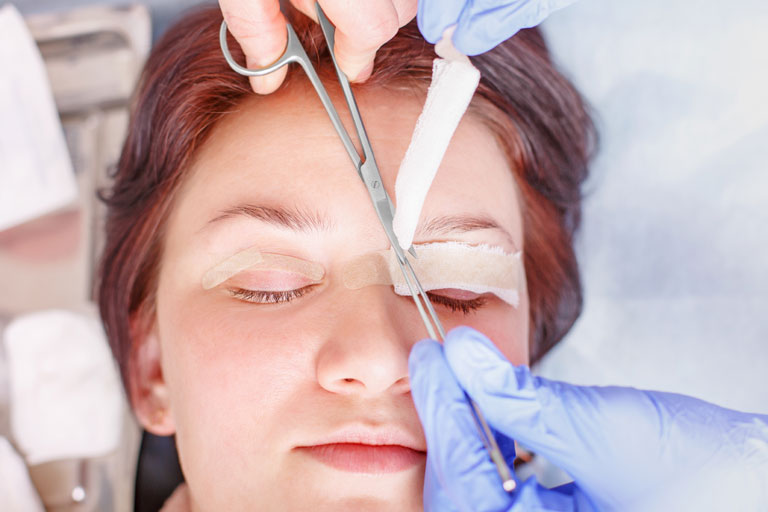Things to Know About Blepharoplasty
Eyelid Surgery
Plastic surgery operations aiming to improve the appearance of the eyes are among the most preferred aesthetic rejuvenation techniques. Last year alone, more than 200,000 men and women underwent eyelid surgery (blepharoplasty) with the help of board-certified plastic surgeons. The sum of the eyelid surgeries performed by all doctors makes this operation the most common cosmetic operation. Patients considering an eyelid surgery should undergo a rigorous evaluation before the operation. This assessment includes patients’ anatomy, eye exams, and eye problems such as dry eyes.
Patients who want to have eyelid surgery have one or more of the following complaints:
- Looking tired
- Heavy, drooping eyelids
- Under-eye bags and swelling
- Excess, wrinkled skin
Most of these problems can be successfully corrected with upper and/or lower eyelid surgeries. These operations focus on improving the three main tissues of the eyelids: skin, muscle and fat. When deciding on the best operations for periorbital improvement, there are some additional physical characteristics that should be evaluated in order to establish the most appropriate treatment plan. Here we are going to explain the important factors that plastic surgeons and patients should consider prior to eye surgery.
Droopy Eyelids: Is This Ptosis?
Most patients who complain about the appearance of their upper eyelids notice that their eyelids are heavy and sagging or they excessive skin. During the upper eyelid surgery, namely blepharoplasty, the excess skin, muscles and fat emerging from under the muscles are removed.
The results of the operation are almost immediately apparent: the shape of the eyelids is improved, the eyes appear more open, and a more rested and renewed image is formed in general. Detailed and error-free examinations should be made before the operation to determine the exact amount of soft tissue to be cut. The differences between the ideal results that men and women seek should also be taken into account in order to avoid removing excess tissue.
In some cases, where the upper eyelids are accumulated excessively on the eye, the eyelids hanging over a part of the visual field may affect the vision. In cases where the eyelid muscles do not work effectively, the medical name for the sagging of the eyelid is ptosis. The reason for this may be congenital or different situations. The function of the muscles that lift the upper eyelid should be examined before the operation so that it can be determined whether these muscles are functioning. This is very important to determine whether any action should be taken for ptosis correction in order to achieve the optimum result. Ptosis repair can be applied together with cosmetic eyelid surgery. In some patients, if the soft tissues in the forehead are loosened and cause the upper eyelid to sag, eyebrow lift surgery can be performed in addition to the eyelid surgery.
Lower Eyelid Skin: Surgery or Non-invasive Treatment?
The most common feature of lower eyelids is that patients want to improve their under eye bags as well. The lower eyelid skin is very thin and delicate, and with age it gets thinner, its wrinkles increase and it starts to look like crepe paper, causing the oil under the skin to appear on the surface. The most important and only permanent improvement in the lower eyelid is usually performed with lower eyelid surgery. This process can also include the removal or repositioning of the underlying muscle layer and the underlying fat. In addition to surgery, the number of non-invasive treatments aimed at improving the appearance of the lower eyelid is increasing.
Lower Eyelid Ptosis: Is Canthopexy Necessary?
All rejuvenation operations applied on the lower eyelid should be personalized for each patient. The possible benefits and inherent limitations of the treatment options must be taken into account in order to achieve optimum results. Creating a solution for skin laxity and excess skin requires a non-surgical treatment that removes excess skin or a surgical procedure that removes it. One of the most important factors to consider when deciding on a surgical or non-surgical procedure is to properly evaluate the lower eyelid and determine whether the lower eyelid is strong enough to maintain its natural shape in the event of any intervention. For patients with loose eyelids, any procedure on the eyelid may cause the eyelid to retract or move from its normal position. To prevent this from happening, patients may need to have a second eyelid surgery. This second surgery (canthopexy), together with the eyelid surgery, can reinforce or balance the effects of surgical procedures to preserve the natural appearance of the eye. Careful and diligent examination before the operation is very important to decide which patients can be good candidates for these operations and to prevent potential complications.
Tear Trough Correction: Adding Volume or Improving Skin’s Surface, or Both?
One of the main results of eyelid aesthetics is the tear trough area, that is, the space between the lower eyelid and cheek. Tear trough may become more visible when the soft tissues on the face lose volume with age and gravity pulls these tissues down. This causes the curvature under the eyelid to become visible, causing dark circles under the eyes. All plans aimed at rejuvenating the eyes should consider the area to determine the best way to heal the tear trough area. Two features of the tear troughs that can be fixed are volume loss and thin, crepe-like skin. The tear troughs can be hidden in the following ways:
- Repositioning the fat in the lower eyelid over the bone edge
- To add volume to the area with fat injection (fat graft or fat transfer) or fillings
The best way to fix the eye fountain may require a combination of operations to achieve the best results.
Eyeball Position: Do You Have Bulging Eyes?
An important part of the pre-eyelid surgery evaluations is the position of the patient’s eye in relation to the bone. Some patients may have eyes protruding in front. While this may have medical reasons, in some cases the cause is genetic. Medical problems should be corrected before eyelid surgery or other aesthetic procedures and patients should be in their best condition. In addition, the surgical technique may need to be adapted to the patient for patients whose eye position is more obvious. Patients should be informed about what the expectations can be as a result of adaptations in the technique. As with all aesthetic operations, the plastic surgeon and the patient should discuss the expectations and the results that can be achieved before the operation.
Upper and lower eyelids can give almost immediate, long-term and noticeable results. Although these operations seem to be simple and understandable operations, the eye area is a very sensitive area and it should be carefully examined before any procedure is applied. Thus, all appropriate techniques and interventions can be performed during the operation. When the eyelid surgery is performed by an experienced and board-approved plastic surgeon and all the details about the patient are considered, it creates very good results and as a result, the patient satisfaction is very high.
If you want to get more information about eyelid surgery, all you need to do is fill out the form down below and someone from our Mediface team will contact you as soon as possible.






